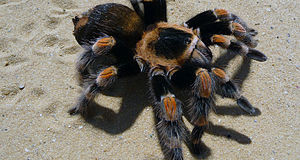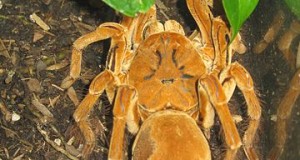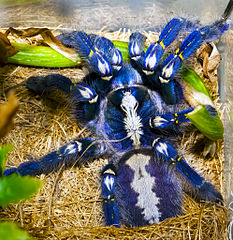Note: Please see Tarantulas in Captivity: An Overview of Popular Species for information on other species and an overview of tarantula-keeping.
Sri Lankan Ornamental Tarantula, Poecilotheria fasciata
Beautifully colored in gray and greenish-brown with an overlying pattern of light gray, these striking, arboreal tarantulas hail from Sri Lanka and neighboring southern India. The undersides of the first 2 pairs of legs are bright yellow, adding greatly to the effect of their threat display.
Although they do well in captivity, it must be remembered that these spiders are fast-moving and high strung, with possibly the most powerful tarantula venoms known (such has not proven dangerous to people, but, as with all venoms, the potential for severe allergic reactions exists). They should not be handled.
Ornamental tarantulas should be housed in a tall terrarium with ample climbing surfaces. A hollow branch or bamboo stick should be provided as a hiding spot – unlike pink-toed and other arboreal spiders, ornamental tarantulas do not construct substantial silken retreats. They occur in habitats subjected to a prolonged dry season – in captivity, a daily misting of water will satisfy their needs. Ornamentals are one of the few tarantulas that can sometimes be kept in groups (the pink toed tarantulas, Avicularia spp., are the other; please see Part I of this article for cautions) – several spiderlings have even been observed feeding upon the same insect! Their diet should consist of roaches, crickets, waxworms and wild-caught insects such as moths.
Suntiger Tarantula, Psalmopoeus irminia
Venezuela’s suntiger is quite large for an arboreal tarantula, and strikingly marked in black and red. These qualities, and its relative hardiness, have added to its popularity in recent years – in fact, this species has even been hybridized with the closely related Trinidad chevron tarantula,
P. cambridgei (the offspring are sterile and not brightly-marked).
Suntigers require high humidity and should be kept in a tall terrarium over a moist substrate and sprayed with water daily. Clumps of damp sphagnum moss wedged among the branches and other climbing surfaces will also help in maintaining moisture levels.
Ravenous predators (feed them crickets, roaches, waxworms, moths and other insects) and quick to “take offense”, these beauties live up to the “tiger” portion of their name quite well!
Haitian Brown Tarantula, Phormictopus cancerides
This species was formerly imported in large numbers, and was relatively inexpensive for such a large spider. The state of Florida now prohibits its sale, and importations have fallen off, but captive-hatched animals are regularly available.
Native to Hispaniola (Haiti and the Dominican Republic) and Puerto Rico, with close relatives in Cuba, this large, ground-dwelling spider is dark brown in color. The males are infused with an attractive purple iridescence. Field reports indicate that they are less likely than other tarantulas to use a specific shelter, and may wander about in search of prey in the manner of wolf spiders.
Haitian browns should be kept on a moist substrate and provided with a cave in which to hide. Females are long-lived, easily reaching the 20 year mark in captivity, but their size and willingness to bite and shed urticating hairs renders them unsuitable for those new to tarantula-keeping. In common with tarantulas from similar habitats, Haitian browns relish earthworms (worms are usually rejected by arboreal and desert-dwelling spiders). They will also take crickets, roaches, wild-caught insects and dead pink mice.
Mexican or Arizona Blond Tarantula, Aphonopelma chalcodes
This is one of the few North American tarantulas to have become popular in the pet trade, and with good reason – adapted to the harsh conditions of their Sonoran Desert (southern Arizona and northern Mexico) home, females can reach ages of 20 years or more in captivity. It is also a beautifully-marked spider that exhibits an unusual degree of sexual dimorphism – females are tawny brown with dark basal (close to body) leg segments, while males are slate blue with orange to reddish abdomens.
Mexican blond tarantulas construct burrows of up to 2 feet in length, the entrances of which are covered with silk by day, apparently to conserve moisture. This species’ life history is strongly influenced by environmental conditions and its activity levels are cyclical in nature. The spiders may remain sealed within their burrows for 6 months at a time, while in July and August the males wander about en masse in search of females.
Mexican blonds should be housed in a terrarium with a deep (they do best if allowed to construct burrows), dry substrate of gravel and sand. They are quite docile, but this should not be taken to mean that they can be carelessly handled (please see Part I of this article). Like all desert-adapted spiders, they require but a light misting of water every few days, and are prone to fungal infections if kept under damp conditions. Captive-born Mexican blond tarantulas, even those several generations removed from the wild, seem tuned to an “internal clock” and may go off-feed for extended periods. As they store a great deal of food in the abdomen, and have experimentally gone without feeding for up to 2 years, this is not a concern for healthy individuals.
Oklahoma Brown Tarantula, Aphonopelma hentzi
This native of the American Midwest is only rarely encountered in the trade, and its care is similar to that of the Mexican blond tarantula (see above).
I mention it here due to an interesting peculiarity in its natural history. The burrows of this spider are often inhabited by the 1 ½ inch long Great Plains narrow-mouthed toad, Gastrophryne olivacea. Despite the amphibian-eating propensities of most tarantulas, the toad remains unmolested by its huge host. Possibly, it is protected by skin toxins or, it is theorized, the toad performs a service by consuming tiny flies, ants and other insects that might parasitize the tarantula or consume its eggs. The toad, in return, receives a safe, moist home and the protection of an aggressive predator.
Scores of other tarantulas and spiders, as well as scorpions, millipedes, pill bugs, centipedes, mantids, roaches and other invertebrates, make fascinating terrarium subjects. It has been my good fortune to have studied a number of species in the wild, and to have helped establish the Bronx Zoo’s invertebrate collection. I will post addition invertebrate-oriented articles from time to time.
A comprehensive, well-illustrated article on tarantula biology and natural history is posted at:
 That Reptile Blog – Reptile, Amphibian and Exotic Pet Care and Information
That Reptile Blog – Reptile, Amphibian and Exotic Pet Care and Information




?????????????????????????????????????????????????????????????????????????????????????????????????????????????????????????????????????????????????????????????????????????????????????????????????????????????????????????????????????????????????????
do you know anything about desert blonde tarantulas???????????????????????????????????????????????????????????????????????????????????????????????
please answer.
Hello,
Frank Indiviglio here. Thanks for your interest in our blog and question.
The Mexican or Arizona blond tarantula, Aphonopelma chalcodes, which is described in the article that you referenced, is often referred to as the desert blond tarantula, so perhaps you are referring to the same species. There are about 35 other species within the genus, however…these are not common in the trade but may also be sold as “desert blond tarantulas”.
Please let me know what additional information you are interested in…I’ll get back to you promptly. Individual blond tarantulas can vary greatly in appearance, so it may be difficult to know exactly what spider you have, or have seen. Photos of several different Arizona blond tarantulas, as well as of other spiders in the same genus, are posted at:
http://www.swiftinverts.com/species/swiftsmiscpage.htm
Best regards, Frank Indiviglio
I am happy you mentioned the Oklahoma Brown by it’s name. Often confused with the Texas Brown, it isn’t as large and have lighter colors. You mention the toads, you see the toads live in the tarantula burrows because the Oklahoma Browns are docile, they only eat smaller insects, and a lizard or two. Because of how the Great Plains are, you see a lot of that coexisting in the environment here, like prairie dogs and Bison.
I feel like I’ve typed way too much lol. As it is, I recommend Oklahoma Browns as pets, they are actually very active and fun to watch.
Hello Lissa, Frank Indiviglio here.
Thanks very much for writing in…it’s not often that I run across people who know much about North American tarantulas, much less have observed them in the wild. Any observations on Oklahoma browns that you would have a chance to pass along (or prairie dogs for that matter – I’ve yet to see them in the wild, despite having cared for hundreds in zoos!) would be most appreciated; do you find the toads often?
I agree concerning co-existence in open habitats such as the Great Plains. Some years ago I had a chance to poke around gopher tortoise burrows in a sandy, open habitat in central Fla. I was working with gopher frogs, which live almost exclusively in gopher tortoise burrows. A whole range of other animals, from spiders to indigo snakes, and even burrowing owls on occasion, rely upon these 20’ long plus burrows, especially during dry periods.
Thanks again, good luck and enjoy.
Best regards, Frank Indiviglio.